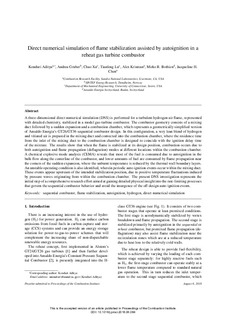| dc.contributor.author | Aditya, Konduri | |
| dc.contributor.author | Gruber, Andrea | |
| dc.contributor.author | Xu, Chao | |
| dc.contributor.author | Lu, Tianfeng F. | |
| dc.contributor.author | Krisman, Alex | |
| dc.contributor.author | Bothien, Mirko R. | |
| dc.contributor.author | Chen, Jacqueline H. | |
| dc.date.accessioned | 2019-01-29T13:38:59Z | |
| dc.date.available | 2019-01-29T13:38:59Z | |
| dc.date.created | 2018-08-06T09:38:58Z | |
| dc.date.issued | 2018 | |
| dc.identifier.issn | 1540-7489 | |
| dc.identifier.uri | http://hdl.handle.net/11250/2582868 | |
| dc.description.abstract | A three-dimensional direct numerical simulation (DNS) is performed for a turbulent hydrogen-air flame, represented with detailed chemistry, stabilized in a model gas-turbine combustor. The combustor geometry consists of a mixing duct followed by a sudden expansion and a combustion chamber, which represents a geometrically simplified version of Ansaldo Energia’s GT26/GT36 sequential combustor design. In this configuration, a very lean blend of hydrogen and vitiated air is prepared in the mixing duct and convected into the combustion chamber, where the residence time from the inlet of the mixing duct to the combustion chamber is designed to coincide with the ignition delay time of the mixture. The results show that when the flame is stabilized at its design position, combustion occurs due to both autoignition and flame propagation (deflagration) modes at different locations within the combustion chamber. A chemical explosive mode analysis (CEMA) reveals that most of the fuel is consumed due to autoignition in the bulk-flow along the centerline of the combustor, and lower amounts of fuel are consumed by flame propagation near the corners of the sudden expansion, where the unburnt temperature is reduced by the thermal wall boundary layers. An unstable operating condition is also identified, wherein periodic auto-ignition events occur within the mixing duct. These events appear upstream of the intended stabilization position, due to positive temperature fluctuations induced by pressure waves originating from within the combustion chamber. The present DNS investigation represents the initial step of a comprehensive research effort aimed at gaining detailed physical insight into the rate-limiting processes that govern the sequential combustor behavior and avoid the insurgence of the off-design auto-ignition events | nb_NO |
| dc.description.abstract | Direct numerical simulation of flame stabilization assisted by autoignition in a reheat gas turbine combustor | nb_NO |
| dc.language.iso | eng | nb_NO |
| dc.publisher | Elsevier | nb_NO |
| dc.rights | Attribution-NonCommercial-NoDerivatives 4.0 Internasjonal | * |
| dc.rights.uri | http://creativecommons.org/licenses/by-nc-nd/4.0/deed.no | * |
| dc.title | Direct numerical simulation of flame stabilization assisted by autoignition in a reheat gas turbine combustor | nb_NO |
| dc.type | Journal article | nb_NO |
| dc.type | Peer reviewed | nb_NO |
| dc.description.version | acceptedVersion | nb_NO |
| dc.source.pagenumber | 2635-2642 | nb_NO |
| dc.source.volume | 37 | nb_NO |
| dc.source.journal | Proceedings of the Combustion Institute | nb_NO |
| dc.source.issue | 2 | nb_NO |
| dc.identifier.doi | 10.1016/j.proci.2018.06.084 | |
| dc.identifier.cristin | 1599825 | |
| dc.relation.project | Notur/NorStore: NN9527K | nb_NO |
| dc.relation.project | Norges forskningsråd: 257579 | nb_NO |
| cristin.unitcode | 7548,70,0,0 | |
| cristin.unitname | Termisk energi | |
| cristin.ispublished | true | |
| cristin.fulltext | postprint | |
| cristin.qualitycode | 2 | |

